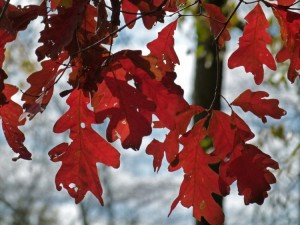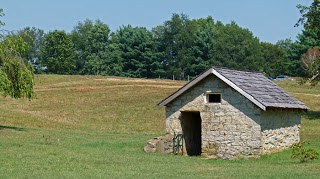 |
| Historic Springhouse |
Despite the record rainfall and floods of spring, the summer has been dry. Looking around the Preserve, not much seems to be in bloom.
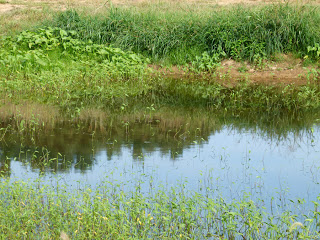 |
| Arrowroot in Upper Pond |
Only a little water is in the upper pond, and some trickles through the springhouse, as always. The small streambed leaving the springhouse is dry and bare as it goes beneath the drive.
 |
| Goldenrod |
As you walk away from the drive, the miracle of nature appears. The water from the Springhouse follows a hidden underground pathway, and suddenly it surfaces. The stream is not large or deep, but it provides the moisture needed for all the autumn wildflowers to bloom profusely. In just a few yards, rich autumn colors and aromas draw in hundreds of pollinators, including beetles, butterflies and bees. Goldenrod is the state flower of Kentucky, and contrary to common belief, it does not cause hayfever. Its pollen is too heavy to float around; the real culprit is Ragweed, which blooms around the same time. There are about 30 species of Goldenrod, so you are right if you think it doesn’t always look the same!
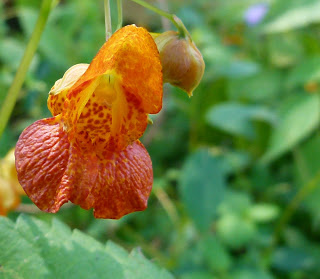 |
| Jewelweed |
One of my favorite late season bloomers is the Jewelweed, which comes in this spotted orange or a yellow version. Hummingbirds and Tiger Swallowtails love the large forward curving spur which is a doorway to nectar heaven. It thrives in moist areas such as our little brook. You may know this one as Touch-me-not, becasue the seed pods burst explosively open when touched! Take a look at my friend’s NatureSpeak blog for terrific details about these delicate flowers.
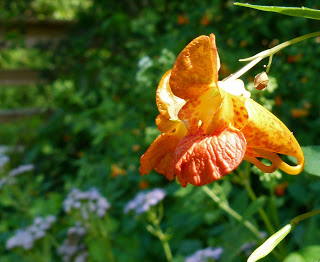 |
| Jewelweed |
Droplets of water standing on the leaves reflect the light and appear jewel-like, hence the common name. Juice from the mashed leaves and stems can be applied as a poultice to skin to alleviate irritation from poison ivy and the sting of nettles. If you see this, pull one of the flowers and rub it on the itch for instant relief! ~Tavia
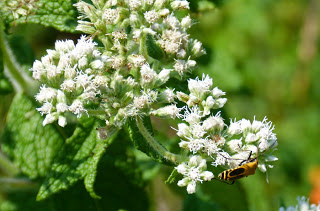 |
| Indian or White Snakeroot |
Snakeroot contains toxins that can pass from cattle to humans through milk, which in pioneer days casued severe illness and often death. This “milksick” disease is thought to have killed Abraham Lincoln’s mother. It was often used by Native American tribes to treat fever, diarrhea, and problems of the urinary tract. ~Tavia
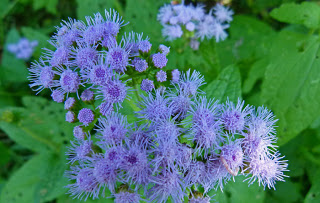 |
| Ageratum or Blue Mist Flower |
Tavia calls this fuzzy flower Ageratum, but I also found it identified as Blue Mist Flower. The little clusters of flowers grow so close together they do look rather misty, don’t they?
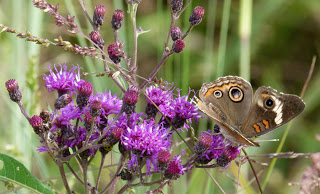 |
| Ironweed and Common Buckeye Butterfly |
Fall is a good time for purple flowers…
 |
| Bull Thistle |
The Scots Thistle is the national emblem of Scotland. Legend says that a Viking invader stepped on a thistle and yelled, alerting the Scots and allowing them to defend themselves from the Norsemen. This superstition continues today that whoever wears the thistle will be safe from harm – unless they step on it, of course! ~Tavia
 |
| Pokeweed |
…and not only purple flowers, but purple berries. Pokeweed is commonly called “Poke Sallet”; you may remember an old song about Poke Sallet Annie (a gator got her Grannie, chomp, chomp!) It’s the only plant I can think of that has the blossom and several stages of ripening dark purple fruit on the same red stem. Just be sure not to park your car nearby, because the birds love these berries!
Early pioneers used the juice of the purple berries for ink, which led to this plant being called Inkweed. Pokeweed is well known in the south as a tasty cooked green. However, the berries, seeds, roots, and mature stems and leaves are very poisonous. ~Tavia
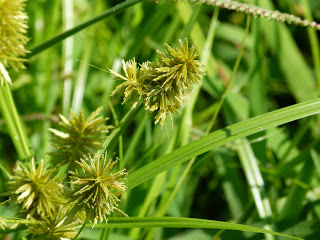 |
| Nutsedge |
“Sedges have edges; rushes are round; grasses are hollow right up from the ground.” I love little poems that help me distinguish similar plants. Although the leaves look like grass, put your fingers on the stem of a sedge and discover that it is triangular in shape! Do the same for a member of the mint family and you’ll find that its stems are square.
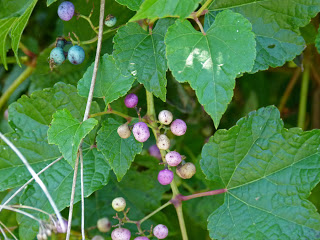 |
| Porcelain Berry Vine |
Vines can be hard to tell apart too, but watch out for the Porcelain Berry vine. With indented leaves and white/blue/purple berries with spots, it looks rather attractive, but it is highly invasive. If you go to the Jefferson County Parks headquarters at Joe Creason Park (across from the zoo) you will find this vine growing on everything that stands still. It will choke them out, killing everything.
The next time you visit the Nature Preserve, walk down by one of our Eagle Scout bridges and take a look at the many fall blooming wildflowers. See if you can find the watercress growing in the brook!
Naturally yours,
~denapple















